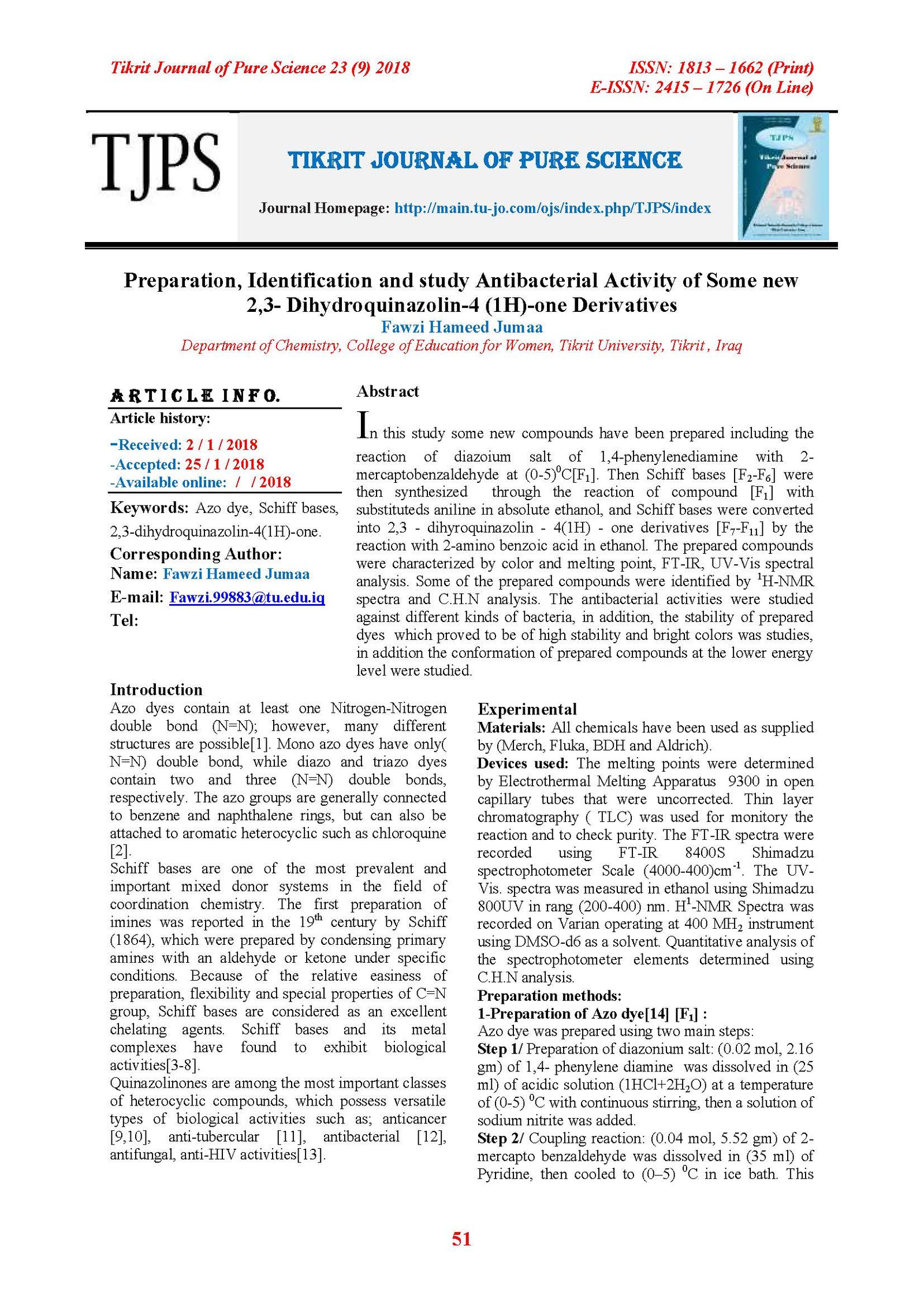Preparation, Identification and study Antibacterial Activity of Some new 2,3- Dihydroquinazolin-4 (1H)-one Derivatives
Main Article Content
Abstract
In this study some new compounds have been prepared including the
reaction of diazoium salt of 1,4-phenylenediamine with 2-
mercaptobenzaldehyde at (0-5)0C[F1]. Then Schiff bases [F2-F6] were
then synthesized through the reaction of compound [F1] with
substituteds aniline in absolute ethanol, and Schiff bases were converted
into 2,3 - dihyroquinazolin - 4(1H) - one derivatives [F7-F11] by the
reaction with 2-amino benzoic acid in ethanol. The prepared compounds
were characterized by color and melting point, FT-IR, UV-Vis spectral
analysis. Some of the prepared compounds were identified by 1H-NMR
spectra and C.H.N analysis. The antibacterial activities were studied
against different kinds of bacteria, in addition, the stability of prepared
dyes which proved to be of high stability and bright colors was studies,
in addition the conformation of prepared compounds at the lower energy
level were studied.
Article Details

This work is licensed under a Creative Commons Attribution 4.0 International License.
Tikrit Journal of Pure Science is licensed under the Creative Commons Attribution 4.0 International License, which allows users to copy, create extracts, abstracts, and new works from the article, alter and revise the article, and make commercial use of the article (including reuse and/or resale of the article by commercial entities), provided the user gives appropriate credit (with a link to the formal publication through the relevant DOI), provides a link to the license, indicates if changes were made, and the licensor is not represented as endorsing the use made of the work. The authors hold the copyright for their published work on the Tikrit J. Pure Sci. website, while Tikrit J. Pure Sci. is responsible for appreciate citation of their work, which is released under CC-BY-4.0, enabling the unrestricted use, distribution, and reproduction of an article in any medium, provided that the original work is properly cited.
References
[1] Hao, O.J. and Chang, P.C. (2000). Decolourization of waste water. Critical Rev. Environ. Sci. Technol, (30): 449-505.
[2] Venkataraman, K. (1970). The Chemistry of Synthetic Dyes. New York and London: Academic Press.
[3] Shelke, V.A. et al. (2012). Journal of Chemistry, (5): 501-507.
[4] Rizwana, B. and Santha, S.L. (2012). Inter.Journal of Chemistry Res. 4(1): 464pp.
[5] Dhakrey, R. and Saxerna, G. (1987). Journan Indan. Chemistry Soc, (64): 685pp.
[6] Suganthi, R.; Santha, S.; Lakshmi, K.G. and Abdul R.A. (2011). Journal Pha. Res, 4(12): 4574pp.
[7] Shouchun, Z. et al. (2004). Journal of Ino. Bio., 98(B): 2099.
[8] Oruc, E.E.; Rollas, S.; Kandemirli, F.N. and Dimoglo, A.S. (2004). Journal. Med. Chemistry, 47(27): 6760 pp.
[9] Jiang, J.B. et al. (1999). Journal Med. Chemistry, (33): 1721 pp.
[10] Xia, Y. et al. (2001). Med. Chem. Lett. (11): 1193.
[11] Trivedi, P.B. et al. (1993). Indian. Journal Chemistry. 32(B): 497pp.
[12] Gangwal, N.A. et al. (2001). Indian. Journal Het. Chemistry, 10: 291pp.
[13] Bartoli, J. et al. (1998). Journal Med. Chemistry, (41): 1869pp.
[14] Fawzi, H.J. and Abdul Wahed, K.A. (2015). Kirkuk University Journal /Scientific Studies (KUJSS), 10(2): 33-57.
[15] Salwa, A.J.; Fawzi, H.J. and Husniya, Q.M. (2015). Tikrit Journal of Pure Science, 20(2).
[16] Mitra, S. (1984). Macromolecular dyes - Synthetic Strategies, Plenum, 185pp.
[17] Rama R.A.; Narendra B.N. (2011). Journal of Pharmacy Research, 4(1): 3-11.
